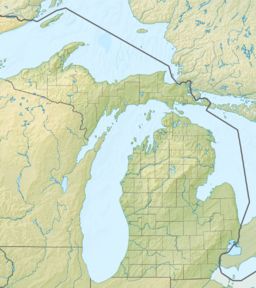| Lake Minong | |
|---|---|
 Glacial Lake Minong | |
| Location | North America |
| Group | Great Lakes |
| Coordinates | 47°42′N 87°30′W / 47.7°N 87.5°W |
| Lake type | former lake |
| Etymology | Historic Name of Isle Royale |
| Primary inflows | From Lake Agassiz through the Nipigon River |
| Primary outflows | Grand River valley in Michigan |
| Basin countries | Canada United States |
| First flooded | 10,000 years before present |
| Residence time | 1,500 years in existence |
| Surface elevation | 450 ft (137 m) |
| References | Glacial and Postglacial Geologic History of Isle Royale National Park, Michigan; N. King Huber; The Geology of Isle Royale National Park, Michigan; Geological Survey Professional Paper 754-A; United States Government Printing Office, Washington, D.C.; 1973. |
Lake Minong was a proglacial lake that formed in the Lake Superior basin during the Wisconsin glaciation around 10,000 B.P. This was the last glacial advance that entered Michigan and covered only part of the upper peninsula. Lake Minong occurred in the eastern corner of the Lake Superior basin while Lake Duluth was in the western end. The lakes became separated when the glacier reached the upper peninsula. Lake Minong expanded to the north as the ice retreated after 9,800 B.P. When the ice retreated from the Keweenaw Peninsula, Lake Duluth merged into Lake Minong.[1]
- ^ "Post-Valders Lake Stages in the Lake Superior Basin", in Glacial and Postglacial Geologic History of Isle Royale National Park, Michigan by N. King Huber, USGS Geological Survey Professional Paper 754-A
